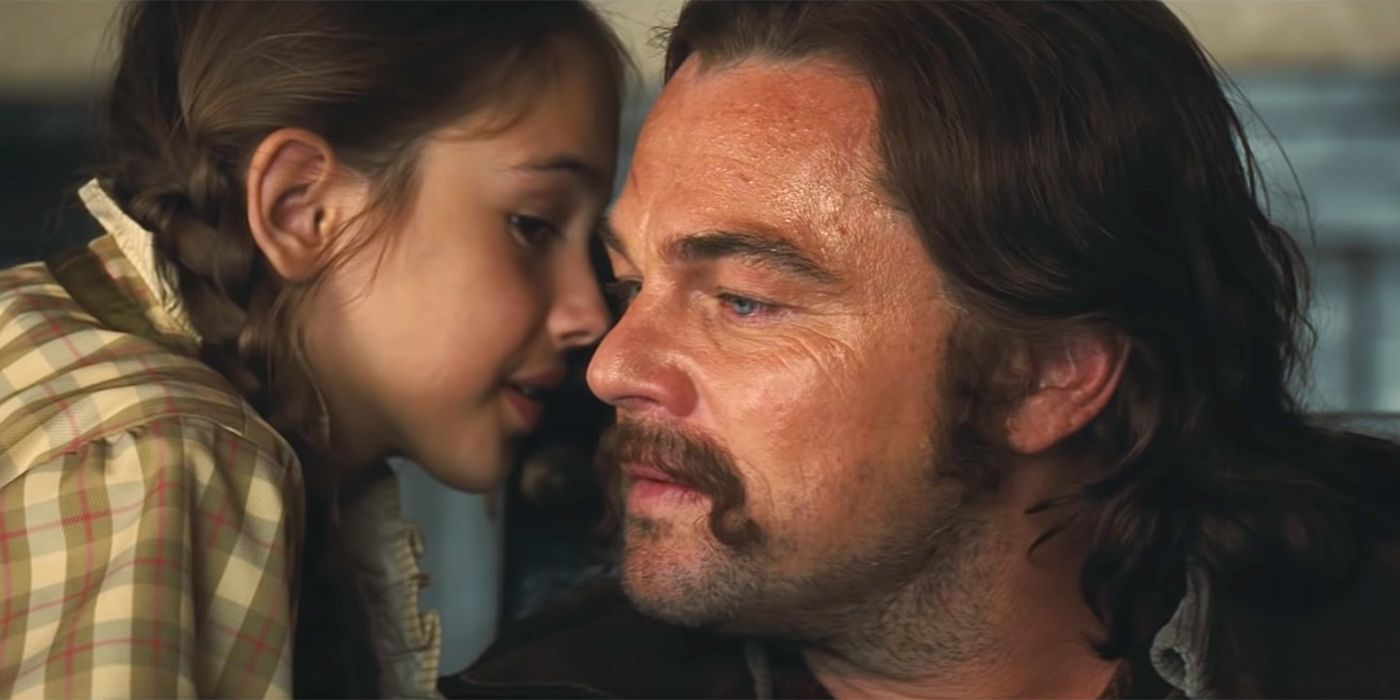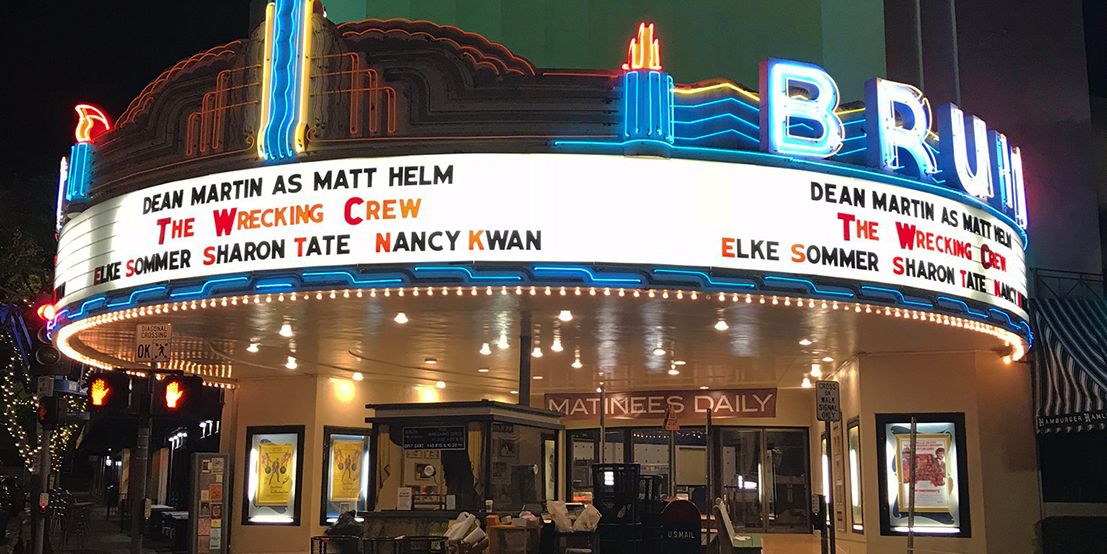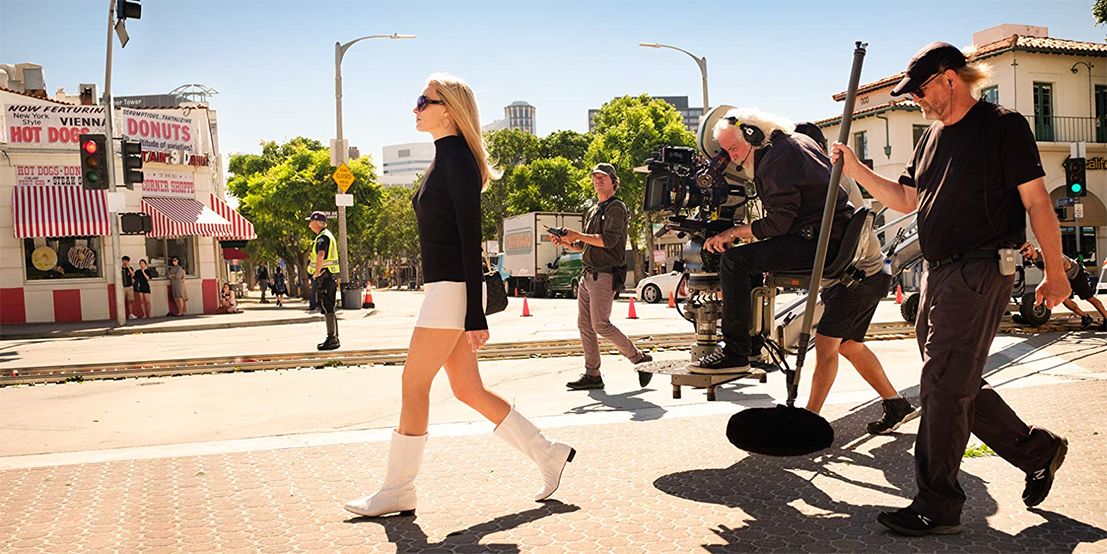Quentin Tarantino’s ninth film, Once Upon A Time In Hollywood, is now available digitally as a special treat for fans. Considering the impressive box office and longevity of the film’s theater run, it’s certain viewers will be thrilled to have a change to experience 1960s Los Angeles from the comfort of their own living rooms. The early home release will soon be followed by 4K, DVD and Blu-ray packages on December 10 courtesy of Sony Pictures Home Entertainment.
To celebrate the arrival of the home release, Sony invited several members of the press to a tour of Hollywood that would highlight just how much had changed between Rick Dalton (Leonardo DiCaprio) and Sharon Tate’s (Margot Robbie) heyday and today. The Once Upon A Time In Hollywood team put in an impressive amount of work to bring an authentic Los Angeles of the period to life, and producer Shannon McIntosh was on hand to talk about the process. She was joined by the young and talented Julia Butters of American Housewife, who went toe-to-toe with DiCaprio onscreen and had glowing praise for both her costar and Tarantino himself.
Did you know anything about Quentin Tarantino when you signed on for this movie?
Julia Butters: I did not. I had no idea who he was. I thought he was another one of those directors; the new-to-the-business people. But when I met him, I felt that he knew what he was doing. And he did. He definitely knew what he was doing. So, I didn't know anything about him.
Quentin’s vision is very precise and very clear. From your point of view, Shannon, is that a blessing or a curse?
Shannon McIntosh: It's a blessing. When you read Quentin’s script, your job’s pretty well-informed from the page. There's a lot of fill-in-the-blanks, but it's amazing. I think that he writes these amazing characters and these amazing scenes, so your job is pretty well laid out when you read the script, and then he gives you more details.
Working with Quentin, I think, elevates everyone in the business. Whether you’re the production designer or the costume designer, he's so well informed about what he wants, and it makes you better at your job. And the same thing is said for me as a producer: sometimes you work with people who aren't 100% clear with what they want, but when he's crystal clear with a vision, it makes your path pretty straightforward.
But the wonderful thing about it is you can go back to him and say, “This isn't gonna quite work this way. Maybe it's another way,” and he listens. If he likes it, then you figure out how to make it work whichever way is best for the picture.
Is that from a cast’s point of view as well or is it purely from the production side? Does he listen to his players?
Julia Butters: He does.
Shannon McIntosh: He does. He absolutely does. I think for this one – Julia can chime in on this - when you talk about Rick Dalton and Leo, he felt like his character in order to get from A to Z may need a little bit more of an arc in the middle. So, they dialogued and talked it out and made it work.
When you look at the trailer sequence in the movie, the freak out, that kind of came after Leo had suggested that “Maybe I should flub up my lines.” That's a very brave actor; most people look at Quentin’s dialogue and go one, “I don't even want to miss an ‘and’ or a ‘the.’” Because he actually would be offscreen going, “But wait, there was an ‘and’ there.” He knows it; he's not looking at it.
Leo was like, “Maybe I should flub it up.” And I think Quentin at first was like, “Flub up my good dialogue?” But he listened to him and said, “Well, let's do it both ways.” Once he did it both ways, we knew that it had to be the flub-up. He knew, and he's the one that had to really decide.
After that, they had the idea for the trailer sequence. So, it was an actor not pushing back but wanting to make it better, and he really listened.
Julia, your character was quite the method actress. After being on set with so many amazing actors, did you learn anything about your craft from them?
Julia Butters: Oh, yes. I really observed them and watched all of them. I kind of learned off of what they would do. I would be, “Oh, okay. They're pretty quiet.” Or, “Oh, okay. They want to stay professional and focused, and they don't want to be all, ‘Hey, how's everybody doing?’ ‘Hey, is there someone I can talk to?’”
If they wanted to, they would go to somebody and start talking to them.
Shannon McIntosh: They learned from her too, let's be honest here. I think that she's so professional at such a young age and so poised, and everyone who worked with her and did scenes with her had an amazing job. Including Mr. Leonardo DiCaprio, who said she was one of the most giving actresses he's ever worked with. And he's worked with a few.
You could hear a pin drop, because people were captivated with her performance and the fact that she's going toe to toe with one of the best actors of our generation. It was amazing to watch. It was a gift. So thank you, Julia. Thank you for teaching us all.
What were the biggest challenges to production?
Shannon McIntosh: Location, location, location. We had about 100 locations, and you're all around Los Angeles. So, figuring out how tactically 1) get the locations to say yes, and 2) how do we checkerboard all around LA.
Adding onto that, all of our actors had schedules. We had a few of our actors that were with us for the most part but, including Margot Robbie, we had to only have her for a certain amount of time. So we had to figure out how to strategically get through these locations while juggling actors or schedules. And there were so many parts; we were constantly casting till almost towards the end, but it was a little bit of a war zone here. How do we get through thing? And then, somehow, we did it.
When it comes to the physical sets, how did you balance cost-effectiveness of CGI with Quentin’s desire to maintain the authenticity of 1960s Hollywood?
Shannon McIntosh: I'm sure it would have been more cost effective to do CGI, but you want it real. You want every inch of your moviegoing experience to feel real. He's an in-camera guy, so what you see was actually shot on the camera. There are a few signs or wires that we had no control over; you have to go back and clean up some. But I think that the authenticity rings through.
We found pictures from the time – if you look at the marquees on the theaters, those all have movies that were actually on the date that it would have happened. We had old newspapers and things like that, just to inform everything that was going on back then.
Here’s what's interesting: had we waited a few months to shoot this movie, I don't know that we could have. Because even around here – the number of buildings that are going down and the high rises that are going up – if I don't drive down a certain street for a few weeks, I'm like, “Oh, there's a new thing there.”
So, we were really blessed to get in when we did, because you actually needed less of the CGI to paint things out. If we did it now, we could probably figure out a way, but there’d be even more CGI just to paint out buildings. Because the buildings are a lot of our history.
You had several characters who were real people at the time. Not just Sharon Tate, but also Bruce Lee and Steve McQueen. What were you looking for when casting those characters and how much research went into the roles?
Shannon McIntosh: Yeah, that was the wonderful thing about this movie is that it's some from Quentin's imagination – no matter what, it’s all from Quentin’s imagination. So even if it's, “What would Steve McQueen have been like?” The dialogue is informed by him. You were balancing, it's real but some of it’s not real.
I think that was the beautiful thing about Rick Dalton living next door to Sharon Tate, because what she represented is what he wanted. He was doing okay on his way down, but she was on her way up. She kind of represented what was a little bit out of reach.
Steve McQueen? A lot of people wanted to play Steve McQueen, but they didn't quite look like Steve McQueen. So, if we can make it work with Damian Lewis, we knew that we were going to make it work with Damian Lewis. And that was another one. We had to shuffle actors with TV shows; he was in Billions, and he'd been on hiatus. Of course, right when we needed them, it was starting right back up.
With Bruce Lee, obviously that's another one. It's [Quentin’s] movie, he wrote how he wanted to write it. But to find that person? We had several people we auditioned, but Mike Moh was in it to win it. His last audition was on the day of our table read. That's when you bring whoever's cast at that point, and you read the script out loud. And Quentin, if the roles aren't cast, assigns some of the actors to read the role. Mike Moh was there to read Bruce Lee, but he also got to read other characters because Quentin thought he did such a great job. He's a really studied and amazing actor, who also happens to be great at martial art. Who knew you can find that?
Did you run into any problems dealing with Sharon Tate’s estate, as far as representation goes?
Shannon Mcintosh: Before we had cast Margot Robbie, no one really had read the script besides a few actors, and rumors got out there. Of course, Debra [Tate] is fierce about protecting Sharon's IP and image in society. We reached out to her immediately, and she and Quentin struck up a wonderful friendship. I will talk to her, still, every other week to this point. She embraced Arianne [Phillips] in costumes. At the moment that we were beginning to costume the movie, she was actually selling off, for the first time, some of Sharon's clothes.
I get really emotional, but it's kismet and really wonderful how we all embraced each other. And what I love so much about the movie, and the thing that really rings true to me, is that Sharon and Jay Sebring can now be remembered for how they should be remembered; for these wonderful, talented beings versus what we know happened to them.
With Bruce Lee, he’s in two scenes in the movie. And one is actually based on facts, where he became the trainer in some of the movies. He was actually suggested for the movie business because of Jay Sebring, a very little known thing. So, that's how he kind of intersects in the world.
We’ve heard that the Blu-ray contains 20 minutes of unreleased footage. Were there any avenues that Quentin wanted to take the story that there wasn't time for?
Shannon McIntosh: We shot everything he wanted to shoot. There were a few things early on that, as we sharpened our pencils and were doing our budget and looking at those locations, there's one scene that was just on the border where you're out of the zone. It just seemed like maybe it wouldn't end up, and so he got real disciplined and said that one can go. We refer to it in the movie, Nebraska Jim.
But we shoot a lot, and you try and make something so it's a manageable time period. In The Hateful Eight, we did an intermission; this one we didn't want an intermission. But, you know, there's definitely some juicy morsels that are on the DVD and Blu-ray that you'll see. If you guys saw The Hateful Eight on Netflix, there was a four-part series in there where we added a little bit more footage that didn't quite make the final cut of the movie. So, there's always reimagining some of those things and making it new and different.
I think there's some great scenes. There was one in particular that's on there, it's a Rick and Sam scene. That's Leo and Nicholas [Hammond], who had an amazing rapport, and you let them kind of riff. He said it's the most Quentin-like dialogue that he didn't even necessarily have to write, but it was a lot of fun. Nicholas Hammond, who was the original Spider-Man for fanboys here; an amazing actor.
I think that you'll see some things are just a little bit longer than what they were in the movie and some things are brand new. It’s a lot of fun.
Once Upon A Time In Hollywood is available on Digital November 22 and on 4K Ultra HD, Blu-ray, and DVD December 10.



